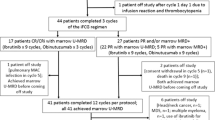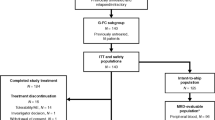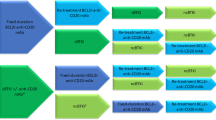Abstract
Alemtuzumab (Campath-1H) is a humanized IgG1 monoclonal antibody that targets the human CD52 antigen. CD52 is expressed by a variety of lymphoid neoplasms and most human mononuclear cell subsets. In 2001, alemtuzumab was approved for marketing in the United States and Europe for use in patients with fludarabine-refractory chronic lymphocytic leukemia (CLL). In heavily pretreated patients with CLL, the overall response rate (ORR) is approximately 35%, and in previously untreated patients the ORR is greater than 80%, with a recent randomized study suggesting it is superior to alkylator-based therapy. Importantly, alemtuzumab is effective in patients with high-risk del(17p13.1) and del(11q22.3) CLL. Alemtuzumab combination studies with fludarabine and/or monoclonal antibodies such as rituximab have demonstrated promising results. Alemtuzumab is also being studied in CLL patients as consolidation therapy for treatment of minimal residual disease, in preparation for stem cell transplantation and to prevent acute and chronic graft versus host disease. Alemtuzumab is frequently associated with acute ‘first-dose’ reactions when administered intravenously, but is much better tolerated when administered subcutaneously without loss of therapeutic efficacy. Additional potential adverse events associated with alemtuzumab administration include myelosuppression as well as profound cellular immune dysfunction with the associated risk of viral reactivation and other opportunistic infections. Additional studies detailing the mechanism of action of alemtuzumab as well as new strategies for prevention of opportunistic infections will aid in the future therapeutic development of this agent.
This is a preview of subscription content, access via your institution
Access options
Subscribe to this journal
Receive 50 print issues and online access
$259.00 per year
only $5.18 per issue
Buy this article
- Purchase on Springer Link
- Instant access to full article PDF
Prices may be subject to local taxes which are calculated during checkout
Similar content being viewed by others
References
Bowen AL, Zomas A, Emmett E, Matutes E, Dyer MJ, Catovsky D . (1997). Subcutaneous CAMPATH-1H in fludarabine-resistant/relapsed chronic lymphocytic and B-prolymphocytic leukaemia. Br J Haematol 96: 617–619.
Buggins AG, Mufti GJ, Salisbury J, Codd J, Westwood N, Arno M et al. (2002). Peripheral blood but not tissue dendritic cells express CD52 and are depleted by treatment with alemtuzumab. Blood 100: 1715–1720.
Byrd JC, Stilgenbauer S, Flinn IW . (2004). Chronic lymphocytic leukemia. Hematology Am Soc Hematol Educ Program, 163–183.
Cartron G, Dacheux L, Salles G, Solal-Celigny P, Bardos P, Colombat P et al. (2002). Therapeutic activity of humanized anti-CD20 monoclonal antibody and polymorphism in IgG Fc receptor FcgammaRIIIa gene. Blood 99: 754–758.
Cheson BD . (2006). Monoclonal antibody therapy of chronic lymphocytic leukemia. Cancer Immunol Immunother 55: 188–196.
Clynes RA, Towers TL, Presta LG, Ravetch JV . (2000). Inhibitory Fc receptors modulate in vivo cytoxicity against tumor targets. Nat Med 6: 443–446.
Crowe JS, Hall VS, Smith MA, Cooper HJ, Tite JP . (1992). Humanized monoclonal antibody CAMPATH-1H: myeloma cell expression of genomic constructs, nucleotide sequence of cDNA constructs and comparison of effector mechanisms of myeloma and Chinese hamster ovary cell-derived material. Clin Exp Immunol 87: 105–110.
Deans JP, Li H, Polyak MJ . (2002). CD20-mediated apoptosis: signalling through lipid rafts. Immunology 107: 176–182.
Delgado J, Thomson K, Russell N, Ewing J, Stewart W, Cook G et al. (2006). Results of alemtuzumab-based reduced-intensity allogeneic transplantation for chronic lymphocytic leukemia: a British Society of Blood and Marrow Transplantation Study. Blood 107: 1724–1730.
Dyer MJ, Kelsey SM, Mackay HJ, Emmett E, Thornton P, Hale G et al. (1997). In vivo ‘purging’ of residual disease in CLL with Campath-1H. Br J Haematol 97: 669–672.
Elsner J, Hochstetter R, Spiekermann K, Kapp A . (1996). Surface and mRNA expression of the CD52 antigen by human eosinophils but not by neutrophils. Blood 88: 4684–4693.
Elter T, Borchmann P, Schulz H, Reiser M, Trelle S, Schnell R et al. (2005). Fludarabine in combination with alemtuzumab is effective and feasible in patients with relapsed or refractory B-cell chronic lymphocytic leukemia: results of a phase II trial. J Clin Oncol 23: 7024–7031.
Faderl S, Thomas DA, O’Brien S, Garcia-Manero G, Kantarjian HM, Giles FJ et al. (2003). Experience with alemtuzumab plus rituximab in patients with relapsed and refractory lymphoid malignancies. Blood 101: 3413–3415.
Faulkner RD, Craddock C, Byrne JL, Mahendra P, Haynes AP, Prentice HG et al. (2004). BEAM-alemtuzumab reduced-intensity allogeneic stem cell transplantation for lymphoproliferative diseases: GVHD, toxicity, and survival in 65 patients. Blood 103: 428–434.
Ferrajoli A, O’Brien SM, Cortes JE, Giles FJ, Thomas DA, Faderl S et al. (2003). Phase II study of alemtuzumab in chronic lymphoproliferative disorders. Cancer 98: 773–778.
Flinn IW, Vogelsang G . (1998). Bone marrow transplantation for chronic lymphocytic leukemia. Semin Oncol 25: 60–64.
Flynn JM, Byrd JC . (2000). Campath-1H monoclonal antibody therapy. Curr Opin Oncol 12: 574–581.
Frampton JE, Wagstaff AJ . (2003). Alemtuzumab. Drugs 63: 1229–1243; discussion 1245–1226.
Garcia A, Cayla X, Fleischer A, Guergnon J, Alvarez-Franco Canas F, Rebollo MP et al. (2003). Rafts: a simple way to control apoptosis by subcellular redistribution. Biochimie 85: 727–731.
Gilleece MH, Dexter TM . (1993). Effect of Campath-1H antibody on human hematopoietic progenitors in vitro. Blood 82: 807–812.
Ginaldi L, De Martinis M, Matutes E, Farahat N, Morilla R, Dyer MJ et al. (1998). Levels of expression of CD52 in normal and leukemic B and T cells: correlation with in vivo therapeutic responses to Campath-1H. Leuk Res 22: 185–191.
Golay J, Manganini M, Rambaldi A, Introna M . (2004). Effect of alemtuzumab on neoplastic B cells. Haematologica 89: 1476–1483.
Hale G . (2001). The CD52 antigen and development of the CAMPATH antibodies. Cytotherapy 3: 137–143.
Hale G, Bright S, Chumbley G, Hoang T, Metcalf D, Munro AJ et al. (1983). Removal of T cells from bone marrow for transplantation: a monoclonal antilymphocyte antibody that fixes human complement. Blood 62: 873–882.
Hale G, Clark M, Waldmann H . (1985). Therapeutic potential of rat monoclonal antibodies: isotype specificity of antibody-dependent cell-mediated cytotoxicity with human lymphocytes. J Immunol 134: 3056–3061.
Hale G, Rebello P, Brettman LR, Fegan C, Kennedy B, Kimby E et al. (2004). Blood concentrations of alemtuzumab and antiglobulin responses in patients with chronic lymphocytic leukemia following intravenous or subcutaneous routes of administration. Blood 104: 948–955.
Hale G, Rye PD, Warford A, Lauder I, Brito-Babapulle A . (1993). The glycosylphosphatidylinositol-anchored lymphocyte antigen CDw52 is associated with the epididymal maturation of human spermatozoa. J Reprod Immunol 23: 189–205.
Hale G, Slavin S, Goldman JM, Mackinnon S, Giralt S, Waldmann H . (2002). Alemtuzumab (Campath-1H) for treatment of lymphoid malignancies in the age of nonmyeloablative conditioning? Bone Marrow Transplant 30: 797–804.
Hale G, Xia MQ, Tighe HP, Dyer MJ, Waldmann H . (1990). The CAMPATH-1 antigen (CDw52). Tissue Antigens 35: 118–127.
Hillmen P, Skotnicki A, Robak T, Jaksic B, Dmoszynska A, Sirard C et al. (2006). Preliminary phase III efficacy and safety of alemtuzumab vs chlorambucil as front-line therapy for patients with progressive B-cell chronic lymphocytic leukemia (BCLL). J Clin Oncol 24: (abstract 6511), 339.
Isaacs JD, Watts RA, Hazleman BL, Hale G, Keogan MT, Cobbold SP et al. (1992). Humanised monoclonal antibody therapy for rheumatoid arthritis. Lancet 340: 748–752.
Juliusson G, Theorin N, Karlsson K, Frodin U, Malm C . (2006). Subcutaneous alemtuzumab vs ATG in adjusted conditioning for allogeneic transplantation: influence of Campath dose on lymphoid recovery, mixed chimerism and survival. Bone Marrow Transplant 37: 503–510.
Keating MJ, Flinn I, Jain V, Binet JL, Hillmen P, Byrd J et al. (2002). Therapeutic role of alemtuzumab (Campath-1H) in patients who have failed fludarabine: results of a large international study. Blood 99: 3554–3561.
Kennedy B, Rawstron A, Carter C, Ryan M, Speed K, Lucas G et al. (2002). Campath-1H and fludarabine in combination are highly active in refractory chronic lymphocytic leukemia. Blood 99: 2245–2247.
Klangsinsirikul P, Carter GI, Byrne JL, Hale G, Russell NH . (2002). Campath-1G causes rapid depletion of circulating host dendritic cells (DCs) before allogeneic transplantation but does not delay donor DC reconstitution. Blood 99: 2586–2591.
Kottaridis PD, Milligan DW, Chopra R, Chakraverty RK, Chakrabarti S, Robinson S et al. (2000). In vivo CAMPATH-1H prevents graft-versus-host disease following nonmyeloablative stem cell transplantation. Blood 96: 2419–2425.
Lenihan DJ, Alencar AJ, Yang D, Kurzrock R, Keating MJ, Duvic M . (2004). Cardiac toxicity of alemtuzumab in patients with mycosis fungoides/Sezary syndrome. Blood 104: 655–658.
Lin TS, Flinn IW, Lucas MS, Porcu P, Sickler J, Moran ME et al. (2005a). Filgrastim and alemtuzumab (Campath-1H) for refractory chronic lymphocytic leukemia. Leukemia 19: 1207–1210.
Lin TS, Flinn IW, Modali R, Lehman TA, Webb J, Waymer S et al. (2005b). FCGR3A and FCGR2A polymorphisms may not correlate with response to alemtuzumab in chronic lymphocytic leukemia. Blood 105: 289–291.
Lozanski G, Heerema NA, Flinn IW, Smith L, Harbison J, Webb J et al. (2004). Alemtuzumab is an effective therapy for chronic lymphocytic leukemia with p53 mutations and deletions. Blood 103: 3278–3281.
Lundin J, Kimby E, Bjorkholm M, Broliden PA, Celsing F, Hjalmar V et al. (2002). Phase II trial of subcutaneous anti-CD52 monoclonal antibody alemtuzumab (Campath-1H) as first-line treatment for patients with B-cell chronic lymphocytic leukemia (B-CLL). Blood 100: 768–773.
Lundin J, Porwit-MacDonald A, Rossmann ED, Karlsson C, Edman P, Rezvany MR et al. (2004). Cellular immune reconstitution after subcutaneous alemtuzumab (anti-CD52 monoclonal antibody, CAMPATH-1H) treatment as first-line therapy for B-cell chronic lymphocytic leukaemia. Leukemia 18: 484–490.
Martino R, Caballero MD, Canals C, Simon JA, Solano C, Urbano-Ispizua A et al. (2001). Allogeneic peripheral blood stem cell transplantation with reduced-intensity conditioning: results of a prospective multicentre study. Br J Haematol 115: 653–659.
Michallet M, Archimbaud E, Bandini G, Rowlings PA, Deeg HJ, Gahrton G et al. (1996). HLA-identical sibling bone marrow transplantation in younger patients with chronic lymphocytic leukemia. European Group for Blood and Marrow Transplantation and the International Bone Marrow Transplant Registry. Ann Intern Med 124: 311–315.
Mone AP, Cheney C, Banks AL, Tridandapani S, Mehter N, Guster S et al. (2006). Alemtuzumab induces caspase-independent cell death in human chronic lymphocytic leukemia cells through a lipid raft-dependent mechanism. Leukemia 20: 272–279.
Montillo M, Tedeschi A, Miqueleiz S, Veronese S, Cairoli R, Intropido L et al. (2006). Alemtuzumab as consolidation after a response to fludarabine is effective in purging residual disease in patients with chronic lymphocytic leukemia. J Clin Oncol 24: 2337–2342.
Moreton P, Kennedy B, Lucas G, Leach M, Rassam SM, Haynes A et al. (2005). Eradication of minimal residual disease in B-cell chronic lymphocytic leukemia after alemtuzumab therapy is associated with prolonged survival. J Clin Oncol 23: 2971–2979.
Morris E, Thomson K, Craddock C, Mahendra P, Milligan D, Cook G et al. (2004). Outcomes after alemtuzumab-containing reduced-intensity allogeneic transplantation regimen for relapsed and refractory non-Hodgkin lymphoma. Blood 104: 3865–3871.
Nguyen DD, Cao TM, Dugan K, Starcher SA, Fechter RL, Coutre SE . (2002). Cytomegalovirus viremia during Campath-1H therapy for relapsed and refractory chronic lymphocytic leukemia and prolymphocytic leukemia. Clin Lymphoma 3: 105–110.
Nuckel H, Frey UH, Roth A, Duhrsen U, Siffert W . (2005). Alemtuzumab induces enhanced apoptosis in vitro in B-cells from patients with chronic lymphocytic leukemia by antibody-dependent cellular cytotoxicity. Eur J Pharmacol 514: 217–224.
O’Brien S, Ravandi-kashani F, Wierda W, Giles F, Thomas DA, Huang X et al. (2005). A randomized trial of Valacyclovir versus Valganciclovir to prevent CMV reactivation in patients with CLL receiving alemtuzumab. Blood 106: (abstract 2960), 830.
O’Brien SM, Kantarjian HM, Thomas DA, Cortes J, Giles FJ, Wierda WG et al. (2003). Alemtuzumab as treatment for residual disease after chemotherapy in patients with chronic lymphocytic leukemia. Cancer 98: 2657–2663.
Osterborg A, Dyer MJ, Bunjes D, Pangalis GA, Bastion Y, Catovsky D et al. (1997). Phase II multicenter study of human CD52 antibody in previously treated chronic lymphocytic leukemia. European Study Group of CAMPATH-1H Treatment in Chronic Lymphocytic Leukemia. J Clin Oncol 15: 1567–1574.
Osterborg A, Fassas AS, Anagnostopoulos A, Dyer MJ, Catovsky D, Mellstedt H . (1996). Humanized CD52 monoclonal antibody Campath-1H as first-line treatment in chronic lymphocytic leukaemia. Br J Haematol 93: 151–153.
Osterborg A, Karlsson C, Lundin J, Kimby E, Mellstedt H . (2006). Strategies in the management of alemtuzumab-related side effects. Semin Oncol 33: S29–S35.
Pérez-Simón JA, Kottaridis PD, Martino R, Craddock C, Caballero D, Chopra R et al. (2002). Nonmyeloablative transplantation with or without alemtuzumab: comparison between 2 prospective studies in patients with lymphoproliferative disorders. Blood 100: 3121–3127.
Perkins JG, Flynn JM, Howard RS, Byrd JC . (2002). Frequency and type of serious infections in fludarabine-refractory B-cell chronic lymphocytic leukemia and small lymphocytic lymphoma: implications for clinical trials in this patient population. Cancer 94: 2033–2039.
Rai KR, Freter CE, Mercier RJ, Cooper MR, Mitchell BS, Stadtmauer EA et al. (2002). Alemtuzumab in previously treated chronic lymphocytic leukemia patients who also had received fludarabine. J Clin Oncol 20: 3891–3897.
Ratzinger G, Reagan JL, Heller G, Busam KJ, Young JW . (2003). Differential CD52 expression by distinct myeloid dendritic cell subsets: implications for alemtuzumab activity at the level of antigen presentation in allogeneic graft-host interactions in transplantation. Blood 101: 1422–1429.
Robak T . (2005). Alemtuzumab in the treatment of chronic lymphocytic leukemia. BioDrugs 19: 9–22.
Rossmann ED, Lundin J, Lenkei R, Mellstedt H, Osterborg A . (2001). Variability in B-cell antigen expression: implications for the treatment of B-cell lymphomas and leukemias with monoclonal antibodies. Hematol J 2: 300–306.
Rowan W, Tite J, Topley P, Brett SJ . (1998). Cross-linking of the CAMPATH-1 antigen (CD52) mediates growth inhibition in human B- and T-lymphoma cell lines, and subsequent emergence of CD52-deficient cells. Immunology 95: 427–436.
Rozman C, Montserrat E . (1995). Chronic lymphocytic leukemia. N Engl J Med 333: 1052–1057.
Smolewski P, Szmigielska-Kaplon A, Cebula B, Jamroziak K, Rogalinska M, Kilianska Z et al. (2005). Proapoptotic activity of alemtuzumab alone and in combination with rituximab or purine nucleoside analogues in chronic lymphocytic leukemia cells. Leuk Lymphoma 46: 87–100.
Sorror ML, Maris MB, Sandmaier BM, Storer BE, Stuart MJ, Hegenbart U et al. (2005). Hematopoietic cell transplantation after nonmyeloablative conditioning for advanced chronic lymphocytic leukemia. J Clin Oncol 23: 3819–3829.
Stanglmaier M, Reis S, Hallek M . (2004). Rituximab and alemtuzumab induce a nonclassic, caspase-independent apoptotic pathway in B-lymphoid cell lines and in chronic lymphocytic leukemia cells. Ann Hematol 83: 634–645.
Stilgenbauer S, Dohner H . (2002). Campath-1H-induced complete remission of chronic lymphocytic leukemia despite p53 gene mutation and resistance to chemotherapy. N Engl J Med 347: 452–453.
Watanabe T, Masuyama J, Sohma Y, Inazawa H, Horie K, Kojima K et al. (2006). CD52 is a novel costimulatory molecule for induction of CD4+ regulatory T cells. Clin Immunol 120: 247–259.
Wendtner CM, Ritgen M, Schweighofer CD, Fingerle-Rowson G, Campe H, Jager G et al. (2004). Consolidation with alemtuzumab in patients with chronic lymphocytic leukemia (CLL) in first remission – experience on safety and efficacy within a randomized multicenter phase III trial of the German CLL Study Group (GCLLSG). Leukemia 18: 1093–1101.
Wierda W, Faderl S, O’Brien S, Cortes J, Ferrajoli A, Giles F et al. (2004). Combined Cyclophosphamide, Fludarabine, Alemtuzumab and rituximab (CFAR) is active for relapsed and refractory patients with CLL. Blood 104: (abstract 340), 101.
Wing MG, Moreau T, Greenwood J, Smith RM, Hale G, Isaacs J et al. (1996). Mechanism of first-dose cytokine-release syndrome by CAMPATH 1-H: involvement of CD16 (FcgammaRIII) and CD11a/CD18 (LFA-1) on NK cells. J Clin Invest 98: 2819–2826.
Xia MQ, Hale G, Lifely MR, Ferguson MA, Campbell D, Packman L et al. (1993a). Structure of the CAMPATH-1 antigen, a glycosylphosphatidylinositol-anchored glycoprotein which is an exceptionally good target for complement lysis. Biochem J 293 (Pt 3): 633–640.
Xia MQ, Hale G, Waldmann H . (1993b). Efficient complement-mediated lysis of cells containing the CAMPATH-1 (CDw52) antigen. Mol Immunol 30: 1089–1096.
Zent CS, Chen JB, Kurten RC, Kaushal GP, Marie Lacy H, Schichman SA . (2004). Alemtuzumab (CAMPATH 1H) does not kill chronic lymphocytic leukemia cells in serum free medium. Leuk Res 28: 495–507.
Zhang M, Yao Z, Zhang Z, Garmestani K, Goldman CK, Ravetch JV et al. (2006). Effective therapy for a murine model of human anaplastic large-cell lymphoma with the anti-CD30 monoclonal antibody, HeFi-1, does not require activating Fc receptors. Blood 108: 705–710.
Acknowledgements
This work supported by the Leukemia and Lymphoma Society, D Warren Brown Foundation, and National Cancer Institute.
Author information
Authors and Affiliations
Corresponding author
Rights and permissions
About this article
Cite this article
Alinari, L., Lapalombella, R., Andritsos, L. et al. Alemtuzumab (Campath-1H) in the treatment of chronic lymphocytic leukemia. Oncogene 26, 3644–3653 (2007). https://doi.org/10.1038/sj.onc.1210380
Published:
Issue Date:
DOI: https://doi.org/10.1038/sj.onc.1210380
Keywords
This article is cited by
-
The intriguing roles of Siglec family members in the tumor microenvironment
Biomarker Research (2022)
-
Precision cancer targeting with antibody pairs
Nature Biotechnology (2022)
-
Logic-gated antibody pairs that selectively act on cells co-expressing two antigens
Nature Biotechnology (2022)
-
CD52-targeted depletion by Alemtuzumab ameliorates allergic airway hyperreactivity and lung inflammation
Mucosal Immunology (2021)
-
The immunological function of CD52 and its targeting in organ transplantation
Inflammation Research (2017)



